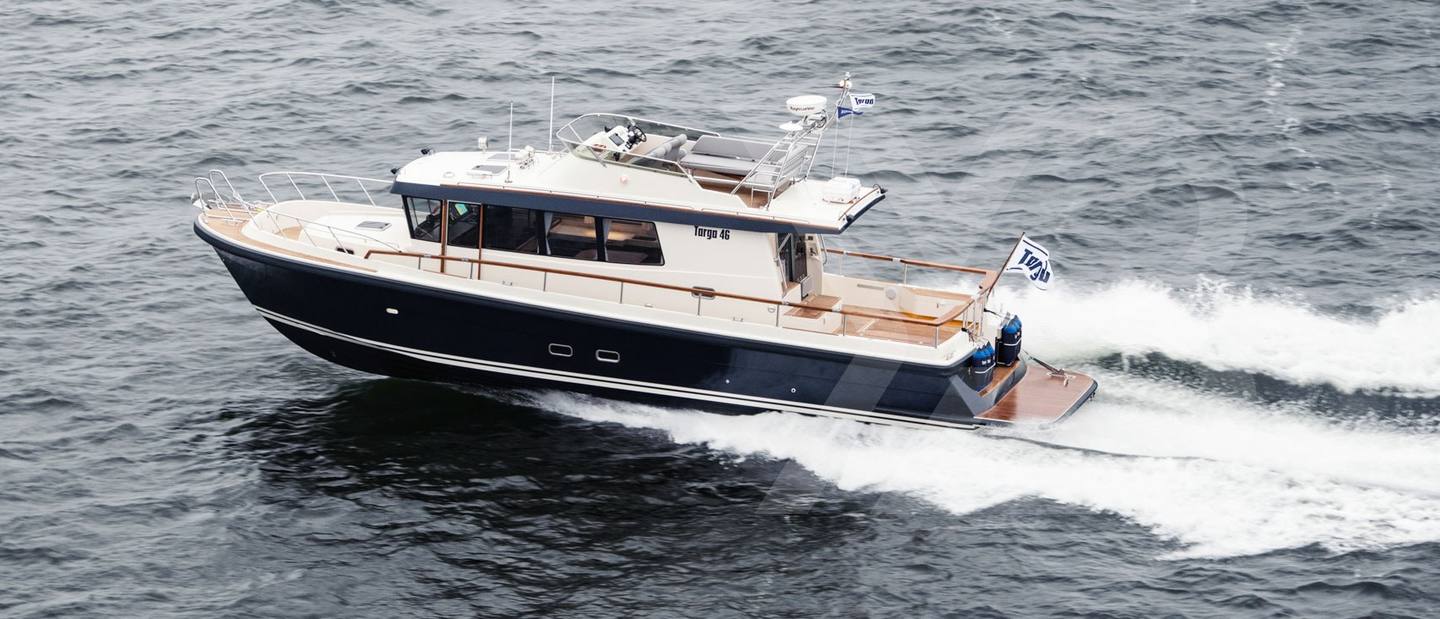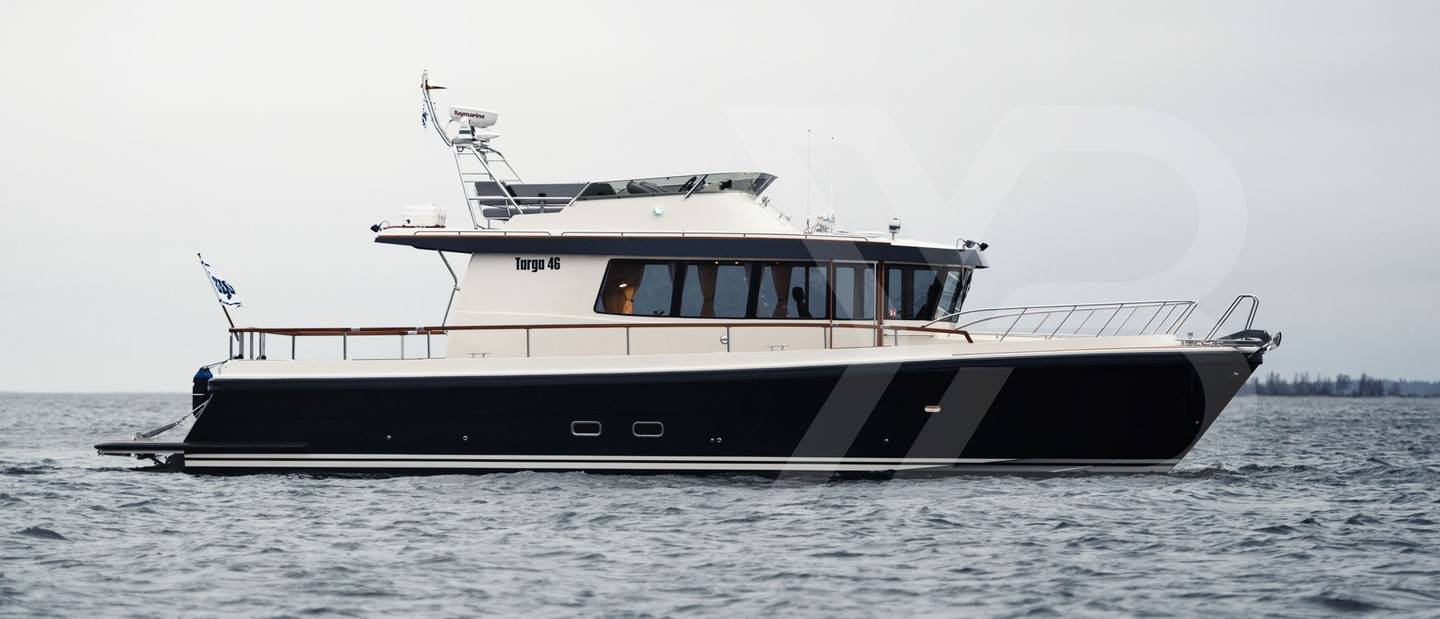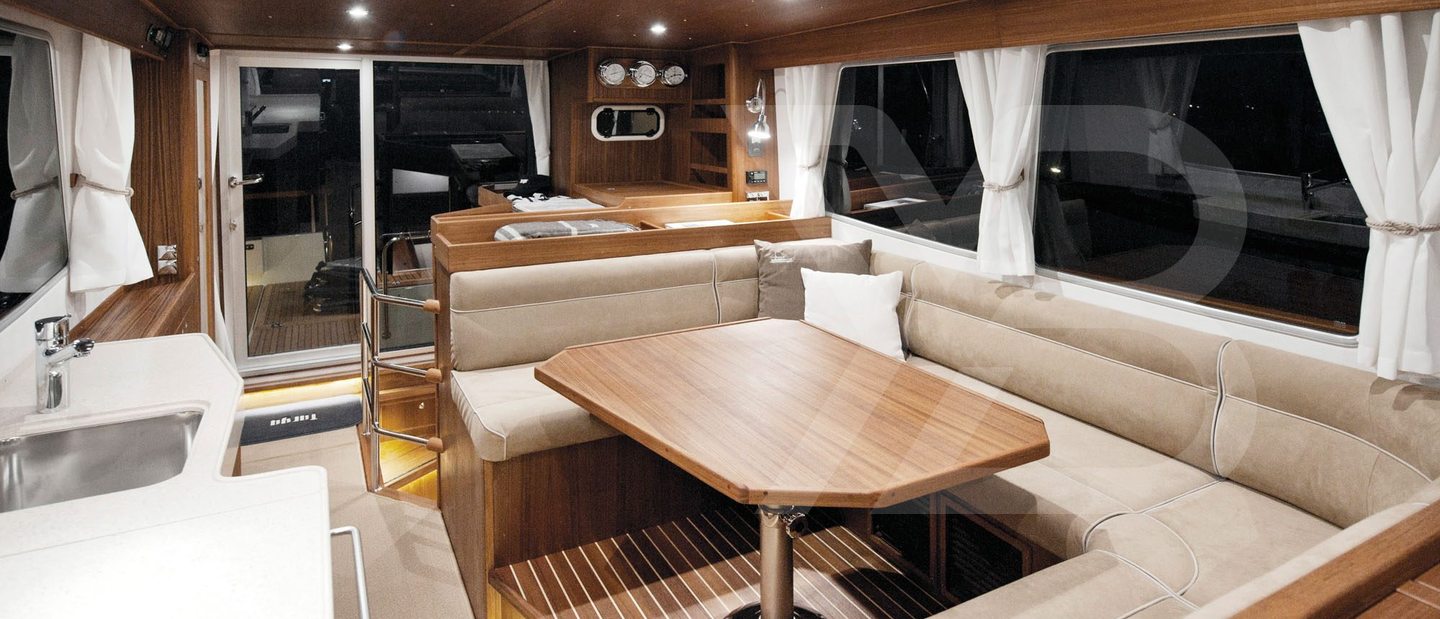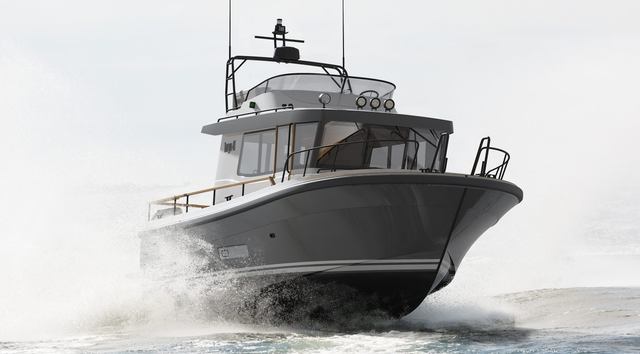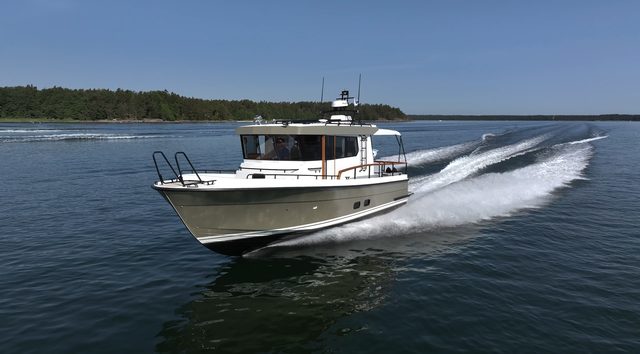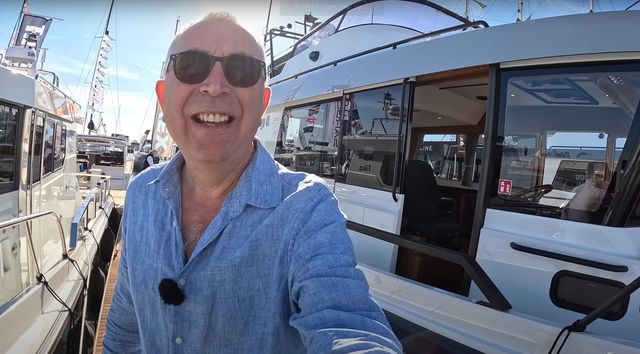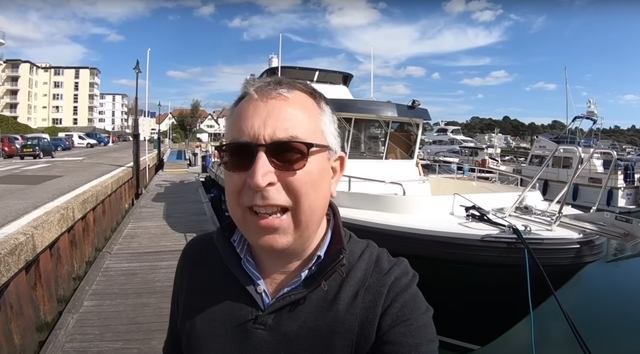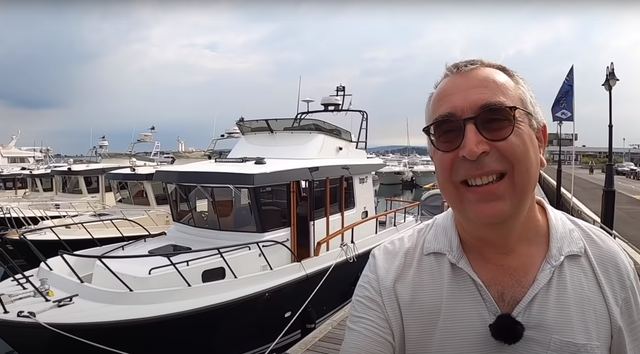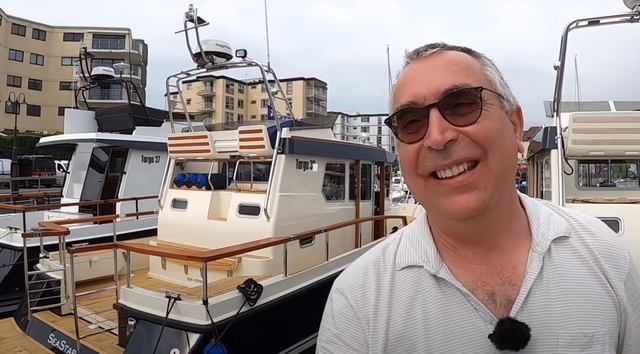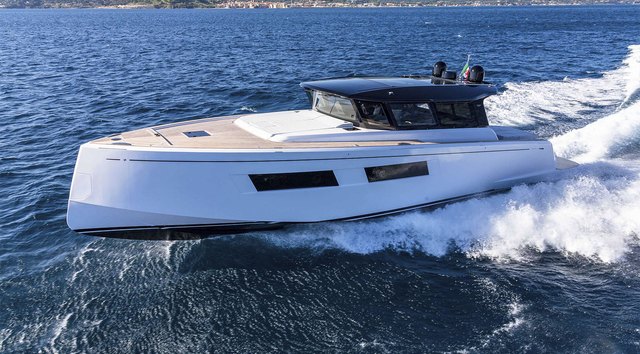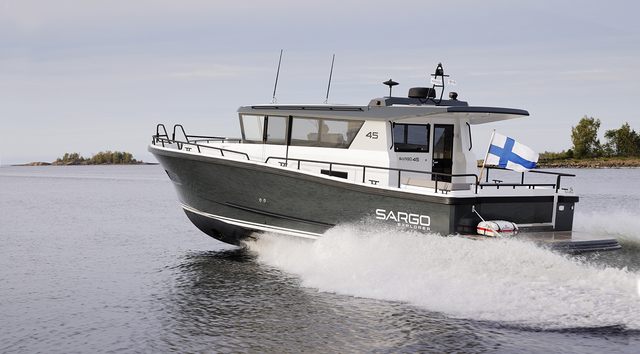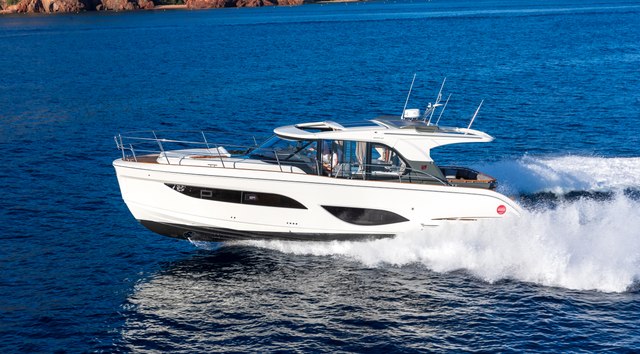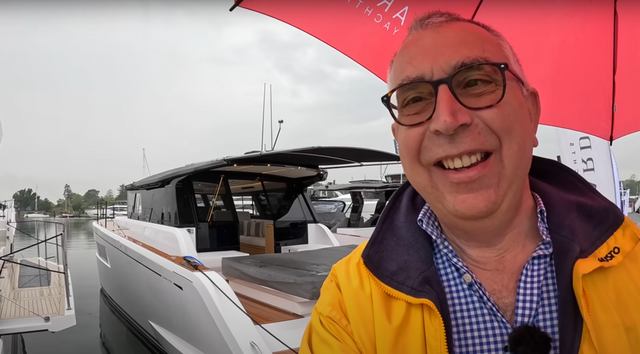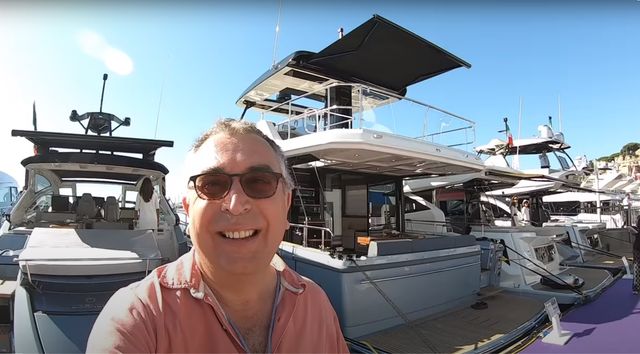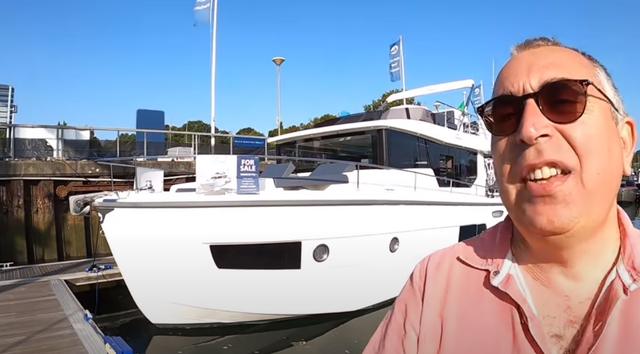Some products define a genre and if you want a 15m (50ft) boat that will go through pretty much anything, Targa is the brand you turn to. But this isn't any Targa, this is the approximately £1,000,000 flagship of the range and if its smaller siblings are anything to go by, this could be one of the most capable boats of its size.
The boat is available with or without a flybridge, with sterndrives or IPS, and with two or three cabins but the thing that all versions share is a laser-guided focus on practicality and usability. You won't see gimmicks here, this is a boat designed with purpose and that purpose is to be used day in, and day out in whatever weather is thrown at it. It faces stiff competition from some fellow Finns, however, so let's delve into the Targa 46 and see if it's as good on board as it appears to be on paper.
Targa 46 Key Facts

- LOA 15.11m
- Model Year 2023
- Cabins 3
- Max Speed 37 knots
- Status In Production
- Yacht Type Wheelhouse
- Use Type Cruising
Test & Review Video
Around the Marina
Don’t let the numbers on the side of the 46 fool you, with the hydraulic bathing platform in place the boat is just over 50ft in length. It’s a strange sensation from the lower helm because, like all Targas, the position is set a long way forward and the view out is pretty much identical to every other boat in the range. Look aft, however, and the boat just keeps stretching out behind you and it’s impossible to see where the bathing platform ends, with or without the tender in place.
It’s a similar story from the upper helm where with the extended flybridge you can’t see the aft end of the boat. For this reason, we would add the cockpit docking station to give the clearest view aft when backing into a berth, which you’ll probably want to do in most situations so it’s easy to jump on and off from the stern. There are side doors on both sides and splits in the bulwarks to improve access off the decks but there is still a clamber to get on and off rather than a proper boarding gate like you get on the Sargo 45.
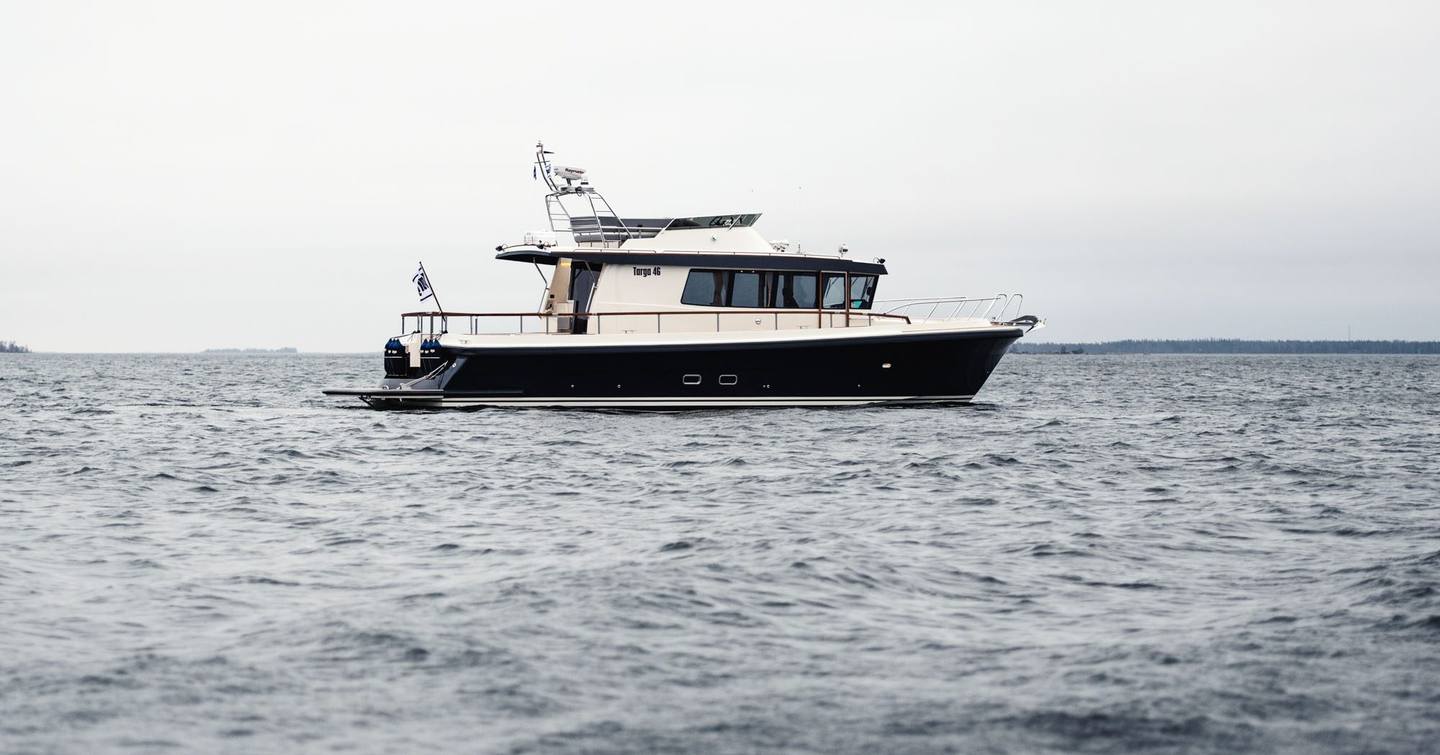
The standard engines are Volvo Penta D6 440s with sterndrives with upgrades to two IPS options: IPS650 (480hp) and IPS800 (600hp). Few boats sold so far have had the larger IPS motors (they're a lot more money for around 2 knots more at the top end and you can't have them with the three-cabin version) and it’s about a 70/30 split in favour of the IPS650s and the standard 440hp sterndrives. Our test boat had the IPS650s and at slow speed, they provide beefy grunt (and quite a lot of engine noise) to shift this long, relatively narrow boat around the marina.
Targas, bless them, have the aerodynamic properties of a garden shed so windage can be an issue but between the meaty diesel engines and upgraded bow thruster the 46 is pretty easy to keep in line. We were working out of Salterns Marina in Poole, one of the most difficult marinas to navigate on the English south coast so this was a good proving ground. An aft-facing camera, as fitted to our test boat, is a must if you want to moor stern-to and do the handling from the lower helm.
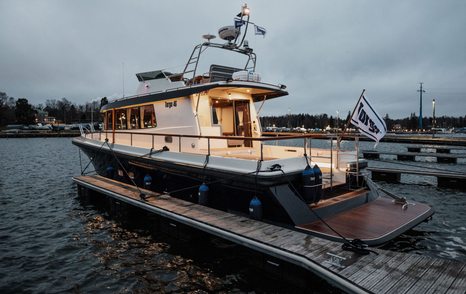
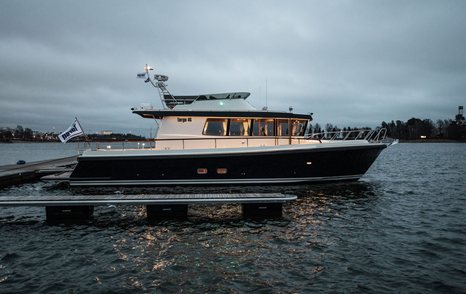
At Sea
The beauty of every Targa is how their unassuming looks shroud dynamic capabilities that would embarrass many sportsboats of similar proportions. In the car world, the Targa 46 would make the ideal “sleeper” because it looks like it’s been designed with a ruler but will actually crack 40 knots with the IPS800s and hit 37 quite comfortably with the smaller IPS motors of our test boat. Think Volvo R estate and you’re on the right lines.
There isn’t anything particularly trick about the Targa hull. There aren’t any steps and it’s not a super deep vee but there’s magic in the mix somewhere because it just works, especially on something as big and fast as the 46. Thankfully, we even had some “Targa weather” to put the boat through its paces because a storm on the previous day had left the remnants of some swell, which was up to 3m at times. A rolling swell with deep troughs is the sort of sea conditions that the big Targa eats for breakfast, the gentle flare of the bow sending great sheets of spray shuddering across the surface of the water and plenty of mid-range grunt from those 6-cylinder Volvos to dig you out of trouble. The hull - the whole boat in fact - feels unwaveringly solid pushing through conditions like this and, of course, from the lower helm you are insulated from what is going on outside.
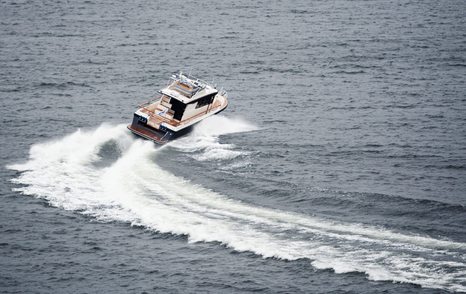
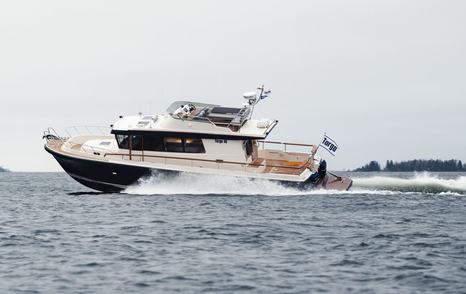
Fun Factor
Downwind things are, if anything, even better. The 46 just loves surging down rollers and the agility of the IPS pods means you can enjoy the conditions and work with the boat to find the most comfortable route through the waves. If driver engagement is important then the standard sterndrives are a good option. They give an extra dose of fine-tuning because you can adjust the angle of the legs independently of the trim tabs, something you can’t do with IPS. And the sterndrives will be more fun to drive. That said, the IPS boat is well-tuned and beautifully balanced. IPS can sometimes feel a bit vague and woolly but the 46 is sharp and, much like with its performance, the handling is a good reminder that you shouldn’t judge a book by its cover.
We’ll cover the helm stations in more detail later in the review but the driving position from the lower helm is outstanding. The optional Grammer suspension seat is a big part of this not only for its ability to soften the impact of hard landings but the amount of adjustment in the seat and dashboard (the whole dash adjusts, not just the wheel) makes it so easy to get comfortable. There is space to stand and drive if you prefer but flip the footest down, slide the seat forward, and tilt the dash downwards and you have the perfect driving position. The boat will do 390nm at a 30-knot cruising speed and you could do every one of them in supreme comfort in this seat.
One of the benefits of the Targa is that it comes with a flybridge so on the days when you don’t require the all-weather protection of the wheelhouse there’s an upper helm to enjoy. Some might say the reason they buy a boat like this is so they don’t have to put up with being battered by the wind but it’s a joyous experience to saddle the Targa from up top and put it through its paces. The view, over a wheelhouse peppered with navigation equipment and other gadgets, is like no other and it’s from here that you can really feel the boat’s agility and its willingness to heave itself into tight turns. Driving a Targa at full chat from the flybridge is one of those unique boating experiences.
The 46 is a development of the 44, which itself was a development of the 42. It has been a slow evolution to get to this point with small tweaks separating the flagships rather than sweeping changes and, most recently, the addition of a three-cabin layout over the standard two-cabin arrangement. Targa design is not about radical changes, you know what you’re going to get and it can often be hard to tell the difference between a boat that’s fresh out of the factory and one that left the sheds 20 years ago.
What you can be certain of is a level of practical detailing and engineering that is out of the top drawer. There are no superfluous design gimmicks aboard a Targa, these boats are about functionality and reliability and that theme is constant, from the engine room installation to the solidity of the catches that hold the sliding doors in place.
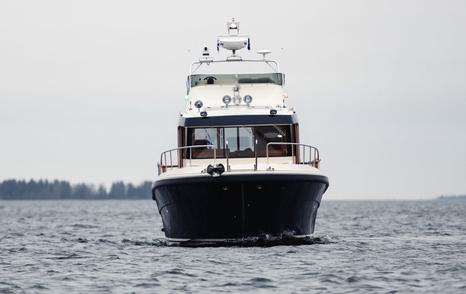
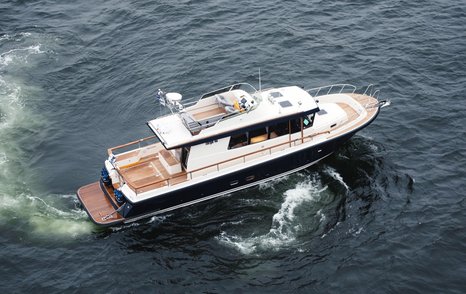
The compromise on smaller models in the range is the dark and sometimes slightly cramped sleeping accommodation but that is less of an issue on a Targa of this scale, as we will discover in the Interior Accommodation section of the review.
The flybridge is something that the Targa shares with its rival Nord Star and something that separates it from the Sargo 45. You can remove it (and save yourself around £20,000) but, as you’ll see in the On Deck section, it’s well worth having even if you don’t think you’ll use it to drive from.
Of course, 15m (50ft) boats cost about £1,000,000 and offer much sexier styling and better living spaces but none of them will look after you and your guests all year round as well as the big Targa.
The cabin spaces can be a fly in the ointment aboard smaller Targas but there are no such issues on the 46, especially with the Comfort Fore Cabin option ticked, as with our test boat. There are two and three-cabin layouts available, the former granting more space in the owner’s cabin, forward, and a single berth tucked underneath the saloon but the popular three-cabin arrangement adds a double cabin amidships, accessed by lifting up a seat in the navigator’s bench. It’s a genius bit of packaging.
There is great privacy in this layout because the guest cabin is at the opposite end of the boat to the owner’s cabin and both have their own bathrooms. There is an open staircase just inside the aft door that leads to the double guest cabin, where there is also a single pipe berth, useful for occasional use and well-suited to kids. There are a few level changes between the lobby, cabin, and bathroom but headroom is good, especially in the bathroom where there is well over 6ft 1in of standing space and a separate shower cubicle. Teak is used liberally throughout the 46’s interior and its presence in the floor grating and cabinets in the bathrooms helps to lift the aesthetic in what would otherwise be quite a plain cubicle.
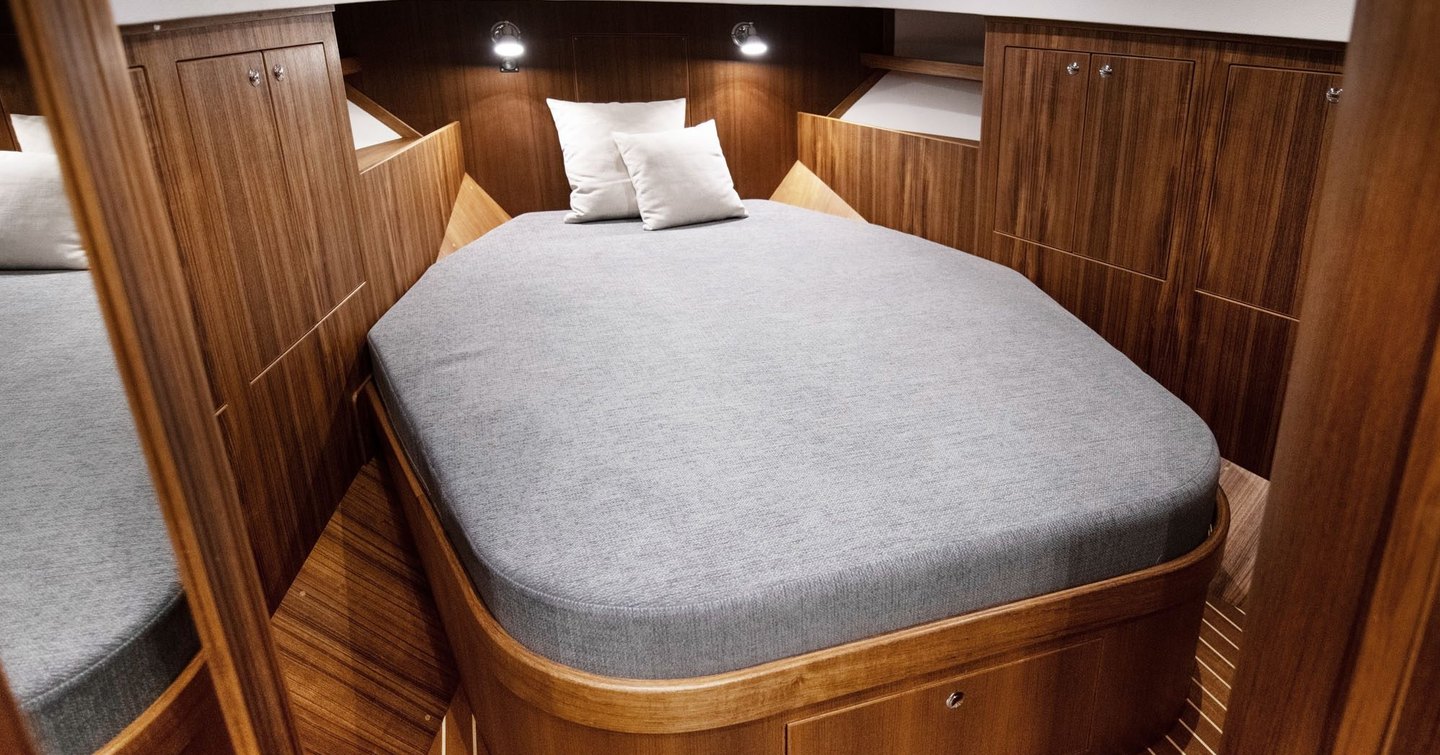
Practical Delights
The saloon is a feast of high-quality teak timbers and practical detailing. Most edges have towering fiddles on them to stop things sliding around and there is a plethora of storage solutions both in the galley and for cruising kit. Smaller Targas have their galleys adjacent to the helm but with so much length to the wheelhouse, there is plenty of space down the starboard side for a long stretch of counter and masses of drawers for storage.
There aren’t many large storage voids but the space is used cleverly and crockery and glasses have dedicated drawers with - you guessed it - teak fiddles to hold them in place. A twin burner induction hob is discreetly hidden under the Corian counter and though there isn’t room for a domestic fridge/freezer there is an under-counter fridge in the galley and another beneath the helm seat. They might be pushed to cater for six people but a couple will have more than enough cold storage. The optional dishwasher, though not huge, will be helpful if the boat is going to be full of guests on a regular basis.
The dinette is adjustable (manually) so you can alter the height of the table and could probably add some cushions to make another double berth if you need, though that will be pushing the boat’s living spaces to their limits.
With the flybridge in place, you can only have a couple of skylights above the helm but remove the top deck and there’s the option to have a solid GRP sunroof, extra glazing aft to draw even more natural light into the saloon, or some solar panels that feed the domestic batteries and reduce the reliance on a generator.
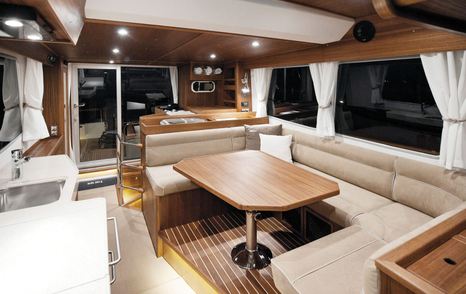
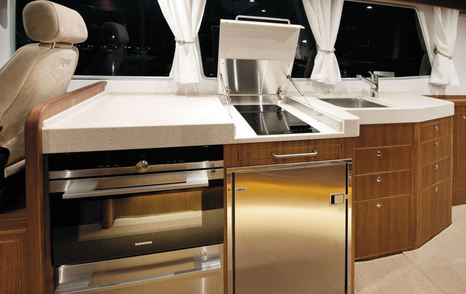
The standard TV looks like something stuck on the wall at a kebab shop and it flips out of the cabinet behind the navigator’s bench but you can upgrade to a 32in one, which fits into a panel in the ceiling in front of the galley. On the two-cabin version, there is space for a pop-up TV in the recess where the third cabin goes.
If you do have the third cabin then access is via a hatch underneath the navigator’s bench, which is actually a lot better than it sounds. Once in, headroom isn’t great over the bed because of the saloon floor above but the bed itself is a decent double and Targa has worked as much storage in as possible given the constraints. One obvious issue is the lack of bathroom access, meaning the occupants will have to clamber out and head to the day head, which is aft and shared with the VIP cabin.
The Comfort Fore Cabin (CFC) is popular for good reason because it creates that bit more headroom and allows for space for the double bed to be set at a more normal height. The downside of this arrangement is that you lose the forward cockpit, which includes a wrap of seating and a table but then this is less of an issue when you have the additional living space of the flybridge deck. For us, the CFC with the extended bathroom is the way to go. Lack of natural light is an issue, though, especially with the cabin door shut, as there are only a couple of small port holes and the skylight above. Some large windows would go a long way in terms of ventilation and natural light inside the cabin.
The lower helm fits like a glove and though it may not be the most exciting dashboard you’ll ever clap eyes on, it, like the rest of the boat, is highly functional. Electronics packages are bespoke to each boat but the owner of the 46 we tested has specced two 16in MFDs on the lower dash with a pair of engine info screens above the windscreens, to supplement the traditional analog dials and a smaller MFD overhead in front of the navigator so they can keep an eye on things too.
There’s a lot of flexibility here but this arrangement worked well. Even with the seat forward, the MFDs are a stretch away but a remote panel mounted adjacent to the seat base means that the screens can be controlled without having to come out of the chair.
Storage is excellent thanks to an assortment of flat cubbies for loose items and navigation tools and a dedicated chart holder means you can keep paper charts on board without them getting in the way.
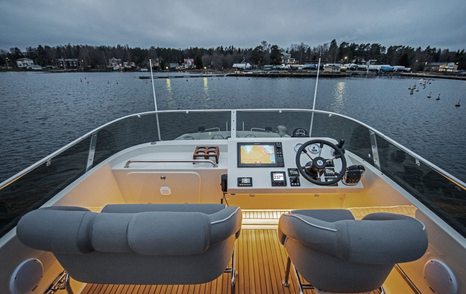
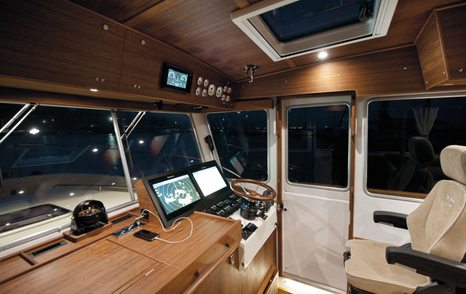
Flybridge Helm
Up top, it’s a real paired-back affair. A single MFD and the bare essentials when it comes to controls means you simply don’t have the suite of information around you like you do downstairs and with only a stubby windscreen for protection you certainly get the wind in the hair experience.
The position is good, though, with a supportive and adjustable bucket seat that is close to the helm so that all of the major controls fall to hand easily. It lacks the storage of the lower helm but it is more of an occasional driving position and, for obvious reasons, most appealing in good weather. For challenging navigation, though, you’ll want to be downstairs.
The Targa 46’s cockpit feels more open and has less furniture than its rivals from Nord Star and Sargo. The benefit is that it functions brilliantly as a working deck if you want to do watersports or go fishing but there isn’t as much fixed furniture as the others and it takes some putting together before it can be used because the tables stow beneath the engine room hatches. Unless you need to lift the hatches again, though, you can leave the tables up for as long as you need and with some director’s chairs set up on the opposite side there’s space for six people to dine outside.
Our test boat has the extended flybridge overhang, which stretches the deck to the transom and creates excellent protection over the aft deck with a set of full covers that can enclose the area and usefully boost the protected living space in bad weather. Storage is pretty good with deep lockers under the benches set in each corner and more under the flybridge steps with the option to have one of them as a cooler.
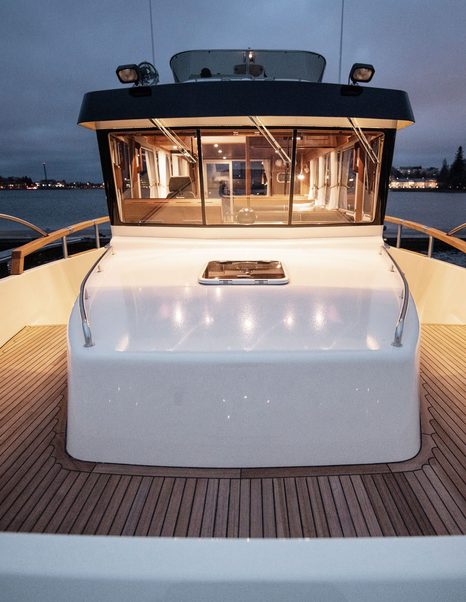
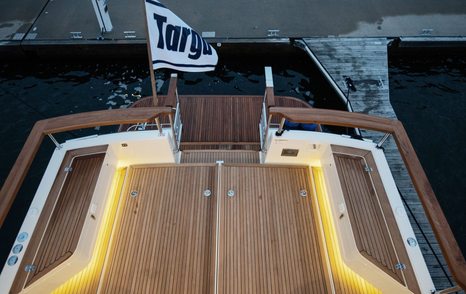
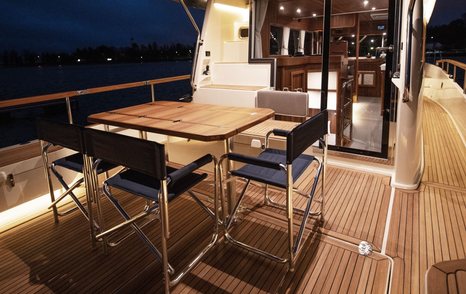
Engine Room
You access the engine room in this area, too, by lifting up two enormous manual deck hatches which reveal both the engines and storage bags on their undersides for the tables and their legs. The engine room is immaculate with outstanding access to both the engines and the IPS pods and all of the ancillary elements such as the generator. A Seakeeper stabiliser is an option that you might want if you’re going to spend a lot of time on anchor or leashed to a buoy. With daily service items easy to get to and extremely tidily laid out cables and plumbing, the Targa 46’s machinery space couldn’t be easier to work in.
Back to the deck, then. The side decks are wide and well protected by handsome teak-capped bulwarks so this is a very easy boat to move around on. Forward, in the CFC version, there is a sun pad on top of the coachroof and very little else. Some aft-facing seats tucked into the bow à la the Sargo 45 would be a good addition but access to the ground tackle and mooring gear is very good and there’s a usefully deep segregated anchor locker.
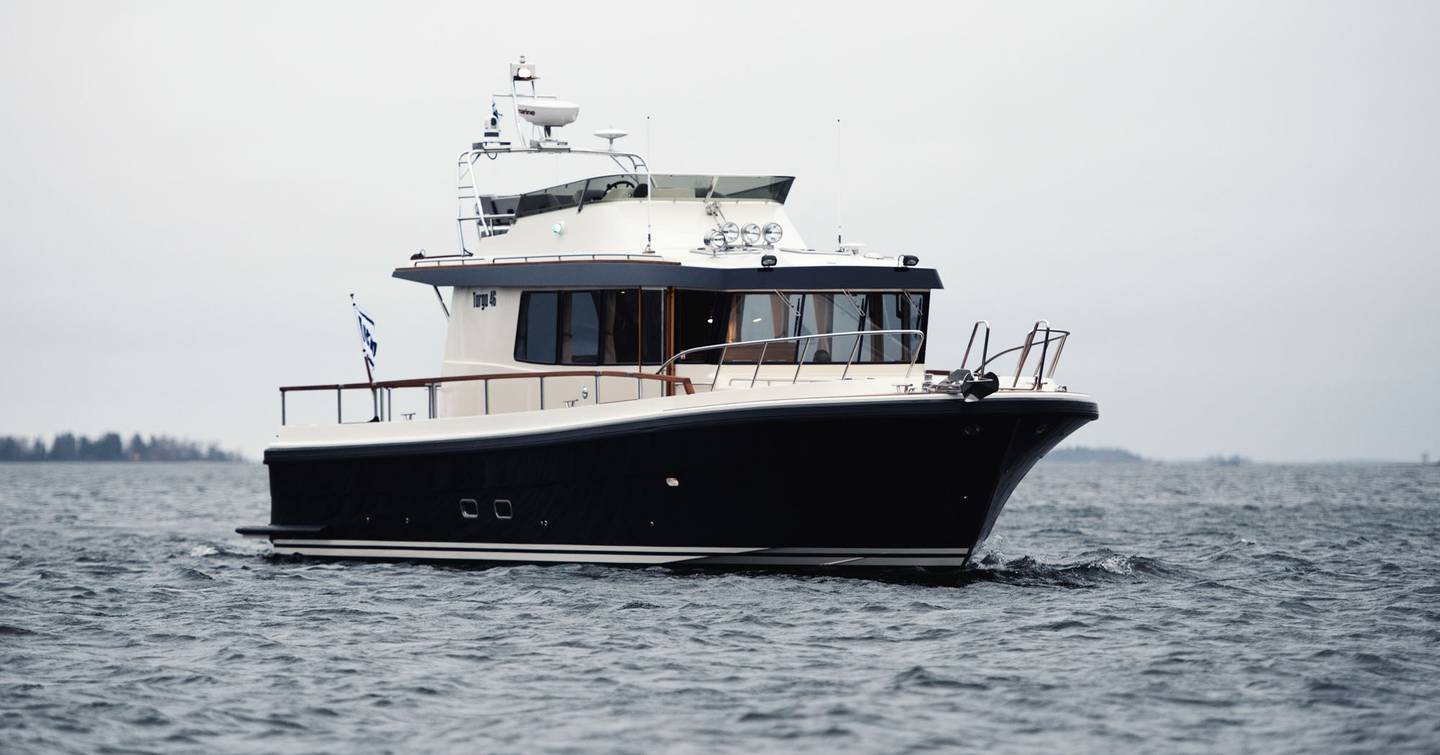
Flying High
The flybridge is a really useful size on the 46 and far more than just an upper driving position as it is on smaller boats in the Targa range. There’s space for an L-shaped bench and a table and because the twin navigator’s seat pivots inboard you could seat five people here for lunch pretty comfortably. There’s no wet bar up here but it’s a great additional seating space that gives you that extra bit of elevation and, if you don’t think you’ll want to drive from up here, Targa will remove the helm station and add even more seating. The extended flybridge also creates a good spot to set up some free-standing furniture or the perfect place to lash down SUPs, windsurfers, or other water toys so they’re safely out of the way and not gobbling up deck or locker space.
The starting price for the 46 is £756,900 ex VAT with sterndrives and £811,300 ex VAT for the IPS650s (approximate prices correct at the time of writing). Targa is relatively generous with its standard specs and includes things like the bow thruster, Eberspacher diesel heating, and Volvo’s Interceptor auto trim system but, of course, this being a boat there is an extensive option to delve into. Our test boat, for example, had around £250,000 of extras and came in at £1,060,000 ex VAT. A lot of money for a boat that comes with compromises in its accommodation, but then there are few leisure boats as capable.
Our Options & Pick
We would opt for the sterndrives for a few reasons. They save you some money at purchase, will make the boat more fun to drive, give you greater control over trim and because the sterndrives can be raised, allow you to enter shallower water.
The three-cabin arrangement (£14,860) with Comfort Fore Cabin (£10,970) and the extra large bathroom (£5,920) works well and we would absolutely keep the flybridge in place. If you’re going to carry a lot of water toys and want plenty of protection in the cockpit then the extended flybridge (£17,970) will suit you but if not the £14,400 shortened version is visually more pleasing.
It’s only £880 to upgrade to the more powerful bow thruster (130kg of thrust over the 100kg standard), so we would do that given the length of the boat and it’s worth pointing out that with the sterndrives you can’t have the bathing platform because the drives are in the way, so that might make the drive system decision for you.
We’d have the 6kW Fischer Panda generator (£24,060) but the £9,600 air-con (20,000 BTU) and Seakeeper will be heavily dependent on where the boat is kept.
Many like the traditional Targa colour schemes but we think the Blackline trim gives the boat a more contemporary look so would add that for £6,810.
Our Verdict
There are sexier 50ft, £1 million boats on the market that offer more in terms of deck space and sleeping accommodation. But to lament that is to miss the point of a boat like the Targa completely. The 46 is about ultimate usability and practicality with the ability to see you through the sort of conditions that most other 50-footers would be running scared from. The real joy is opening it up and unleashing its surprisingly potent performance and handling. In rough weather, few boats of this size would be able to keep up with it. There are compromises, no question, but for comfortable year-round boating look no further.
Reasons to Buy
- All weather capability
- Practical detailing
- Performance and handling
- Quality construction and finishing
Things to Consider
- Accommodation isn't the most spacious
- Looks won't suit everyone
- Sparse cockpit
Looking to own a Targa 46? Use YachtBuyer’s Market Watch to compare all new and used Targa 46 Boats for sale worldwide. You can also order a new Targa 46, customized to your exact specifications, with options for engine choice and layout configuration. Alternatively, explore our global listings of new and used boats for sale and find your perfect boat today!
Rivals to Consider
Few boats have such direct rivals as the Targa, both of which are built within a few hundred kilometres of where the 46 is built.
The Sargo 45 is slap bang in Targa 46 territory and has many similarities. It too is available with sterndrives and IPS (the same options as the Targa minus IPS800) and you can have it with two or three cabins. It has a more leisure-focussed cockpit with fixed L-shaped seating and a large table that doesn't need to be removed to access the engine room. Deck storage is outstanding and it's just as practical as the Targa. It currently isn't available with a flybridge, however, so if that's a key part of the attraction you'll want the Targa or the Nord Star. There are some key differences between Targa and Sargo, the most obvious being the way the interior is laid out. The amidships cabin, which has an ensuite and is accessed via the navigator's bench like the Targas, is standard as is the forward owner's ensuite. Opt for three cabins and you lose some space in the master but gain a decent double that is accessed via the same companionway as the forward cabin. It is, arguably, a better layout than the Targa's. There's little to split them when it comes to handling and performance, or price for that matter.
The other key rival is the Nord Star 49. Slightly less expensive than the other two, the 49's interior layout is completely different and is more in line with the arrangement of a coupe sportscruiser or flybridge of this size. In that, it has an aft galley layout that opens out onto the cockpit and a more open L-shaped dinette amidships with a wider companionway down the starboard side and a commanding helm station with twin captain's chairs. On the lower deck, there are only two cabins but there is space for a double ensuite forward and a luxurious full-beam cabin amidships with its own bathroom. It, like the Targa, is available with a flybridge and though it's not as large as its rival's top deck, it's well-designed and incorporates a neat bimini to provide some shade. The 49 is IPS only with the same options as the Targa, IPS650 or 800 for a claimed top speed of 35 knots. Slower than the Targa, then, but it is around 3 tonnes heavier than the 46. The Nord Star name may not be as well known as the other two but the 49 has plenty going for it.
Considering a new boat? Explore Targa's entire current range to find the model that best suits your needs, and compare it with alternatives from competitors to ensure you make the perfect choice.
Specifications & Performance
- Builder Targa
- Model Targa 46
- Length Overall 15.11m
- Beam 3.95m
- Draft 1.1m
- Hull GRP
- Cabins 3
- Berths 6
- Yacht Type (Primary) Wheelhouse
- Use Type (Primary) Cruising
- Cruising Speed
- Max Speed
- Fuel Capacity 1,500 Litres
- Fresh Water Capacity 350 Litres
Performance Data
Targa 46 version 2023. *Data collected by YachtBuyer during testing.
- RPM
- Knots
- Liters Per Hour
- Liters Per Mile
- Range (nm)
- Decibels
-
- ECO
- 1,000
- 6.7
- 9
- 1
- 1,116
- 59
-
- 1,400
- 8.7
- 23
- 3
- 567
- 65
-
- 1,800
- 10.6
- 48
- 5
- 331
- 66
-
- 2,200
- 15.3
- 66
- 4
- 348
- 69
-
- 2,600
- 22.5
- 90
- 4
- 375
- 72
-
- CRUISE
- 3,000
- 30.0
- 116
- 4
- 387
- 74
-
- 3,400
- 33.0
- 151
- 5
- 328
- 75
-
- MAX
- 3,600
- 37.0
- 187
- 5
- 297
- 76
Yacht Load: 20 Litres of water 75 Litres of fuel 3 members of crew air temperature of 21 °C
Sea Conditions: F2, moderate
Interested in a Targa 46?
NEW Build
Find your local dealer for a personalised, no-cost consultation
or just request
Brochures & Pricing
Used & In Stock
Looking for a ready-to-go Targa 46 or pre-owned options? Explore all inventory of the Targa 46 available worldwide
